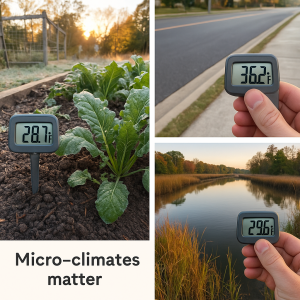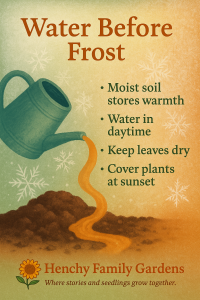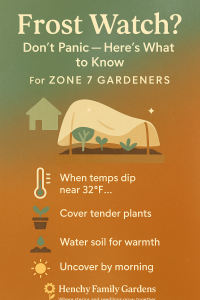As the evenings grow crisp here at the Jersey Shore, gardeners in USDA Growing Zone 7 — including our community in 08731 — start hearing those familiar words from local forecasts: “Frost Watch.”
But what does that really mean, especially when your thermometer still reads 44°F? Let’s dig in together and uncover the science, the signs, and the simple ways to protect your garden family from Jack Frost’s surprise visits.

“Frost is the garden’s whisper that every ending holds a promise — that rest is not the death of beauty, but its preparation to bloom again.”
— Henchy Family Gardens
🌱 What Is a Frost, Really?
“When the air turns still and silver, even the smallest leaf remembers how to sparkle.”
A frost happens when air temperatures drop to around 32°F (0°C) or below, and moisture in the air crystallizes directly onto plant surfaces — those tiny ice crystals you see on petals and leaves in the morning.

Light Frost (29–32°F): May damage or kill tender plants such as basil, peppers, or impatiens.
- Moderate Frost (25–28°F): Hardier plants begin to feel it — tomatoes, beans, and annual flowers are at risk.
- Hard Freeze (below 25°F): Most unprotected vegetation suffers serious damage, marking the end of the growing season for warm-weather crops.
🧭 Typical Frost Dates for Zone 7
(Southern NJ)
In our coastal region, the average first frost arrives around mid-to-late October, and the last spring frost usually passes by mid-April. That gives gardeners roughly a 200-day growing season — long enough to enjoy multiple harvests and plenty of flowers before the cold sets in.
🌤 Why You Can Get a Frost Warning at 44°F
It might sound strange, but a frost watch can be issued even when the forecast temperature is in the low-to-mid 40s. Here’s why:
- Clear skies allow heat to escape rapidly after sunset.
- Calm winds mean there’s no air movement to keep temperatures mixed.
- Low-lying garden beds can be several degrees cooler than official readings.
- Surface temperatures — the air just above your plants — can dip to freezing even while your thermometer reads higher.
Think of it as a quiet, invisible chill that creeps in overnight — gentle but enough to nip tender leaves if left uncovered.
🪴 What to Do When Frost Is in the Forecast

- 🌼 Cover tender plants with old sheets, burlap, or frost cloth before sunset.
- 🏡 Bring containers indoors or group them near a protected wall.
- 💧 Water the soil lightly — moist soil holds heat better than dry soil.
- 🌤 Uncover in the morning once the sun rises and temperatures climb.
- 🌾 Check microclimates: garden corners, dips, and near fences may freeze first.
💛 A Final Word from the Garden 💛

At Henchy Family Gardens, we see frost as more than just a seasonal warning — it’s a gentle reminder that every garden (and every gardener) moves through seasons of rest and renewal.
So when that cool air rolls in and your garden glistens under the morning dew, take a deep breath. Protect what you can, learn what nature teaches, and trust that spring will always follow.
🌻 Henchy Family Gardens
“Where stories and seedlings grow together.”

